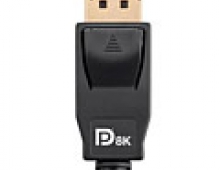
VESA Improves Device Battery Life and Performance with DisplayPort Version 1.4
The latest version of VESA's embedded display interface
includes new features that will further reduce system power
consumption, support multi-touch data over the display
interface, and support a wider range of platform topologies
including tablets, handheld devices, and notebook PCs.
The Video Electronics Standards Association (VESA) today
announced the upcoming release of Embedded DisplayPort
(eDP) Version 1.4.
eDP v1.4 addresses system power reduction through new features, including a new partial-frame update capability for Panel Self Refresh (PSR), lower interface voltage swings, additional link rate options, transport data compression, and regional backlight control. The auxiliary channel will now carry multi- touch data from the display to system processor. eDP v1.4 electrical interface parameters have also been enhanced to accommodate a wider range of system form factors and transmission media.
First introduced in 2009 as an extension of the DisplayPort standard, eDP was developed to replace the aging LVDS (Low-Voltage Differential Signaling) embedded display interface standard. In 2010, VESA member companies AMD and Intel announced that they would be phasing out LVDS support in next generation chip sets by 2013 in favor of eDP because of LVDS' limited capabilities, higher voltage levels requirements, and excessive interference with system wireless communication functions. Currently undergoing final review by VESA members, eDP1.4 is anticipated to be released in October 2012, and utilized in commercial products as early as 2014.
eDP v1.4 addresses system power reduction through new features, including a new partial-frame update capability for Panel Self Refresh (PSR), lower interface voltage swings, additional link rate options, transport data compression, and regional backlight control. The auxiliary channel will now carry multi- touch data from the display to system processor. eDP v1.4 electrical interface parameters have also been enhanced to accommodate a wider range of system form factors and transmission media.
First introduced in 2009 as an extension of the DisplayPort standard, eDP was developed to replace the aging LVDS (Low-Voltage Differential Signaling) embedded display interface standard. In 2010, VESA member companies AMD and Intel announced that they would be phasing out LVDS support in next generation chip sets by 2013 in favor of eDP because of LVDS' limited capabilities, higher voltage levels requirements, and excessive interference with system wireless communication functions. Currently undergoing final review by VESA members, eDP1.4 is anticipated to be released in October 2012, and utilized in commercial products as early as 2014.




















